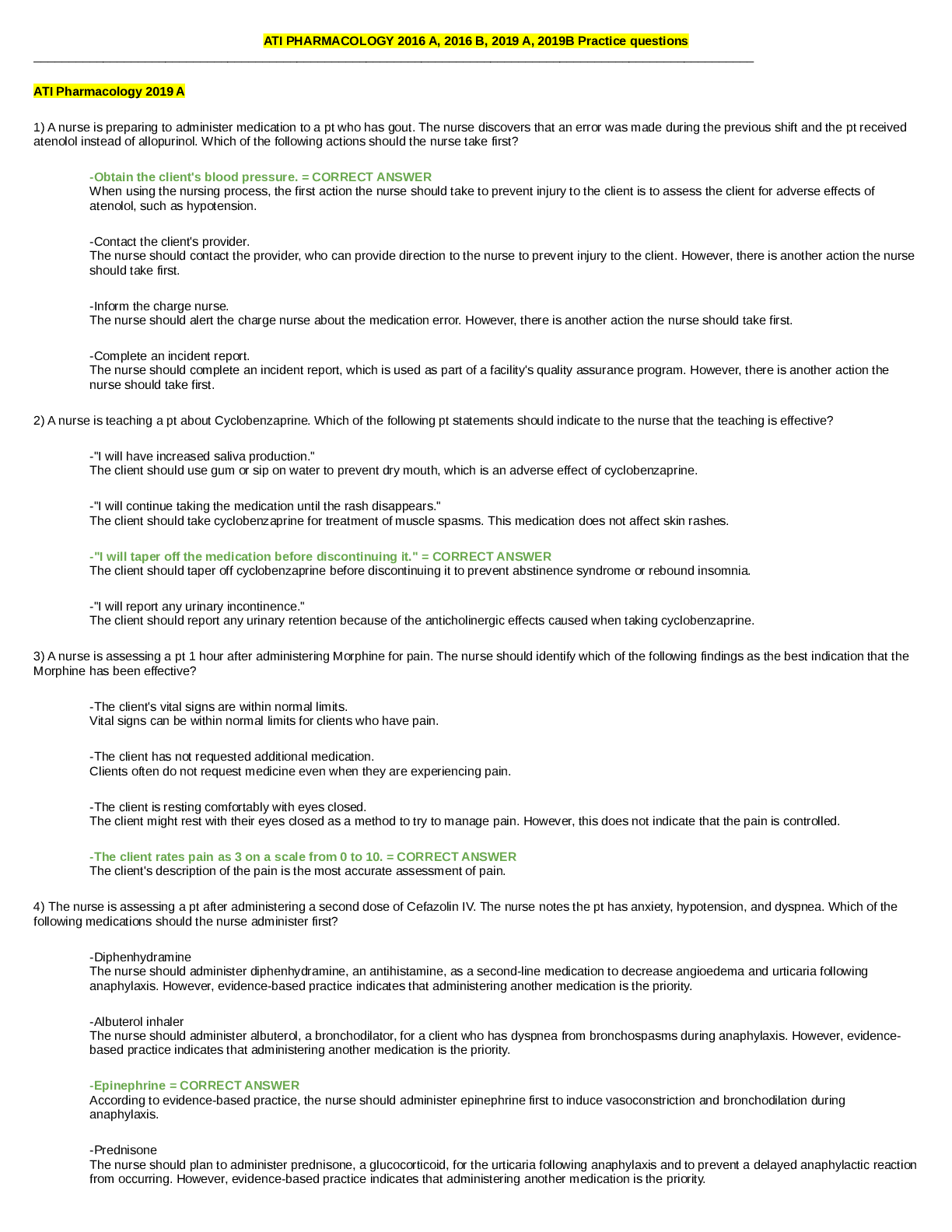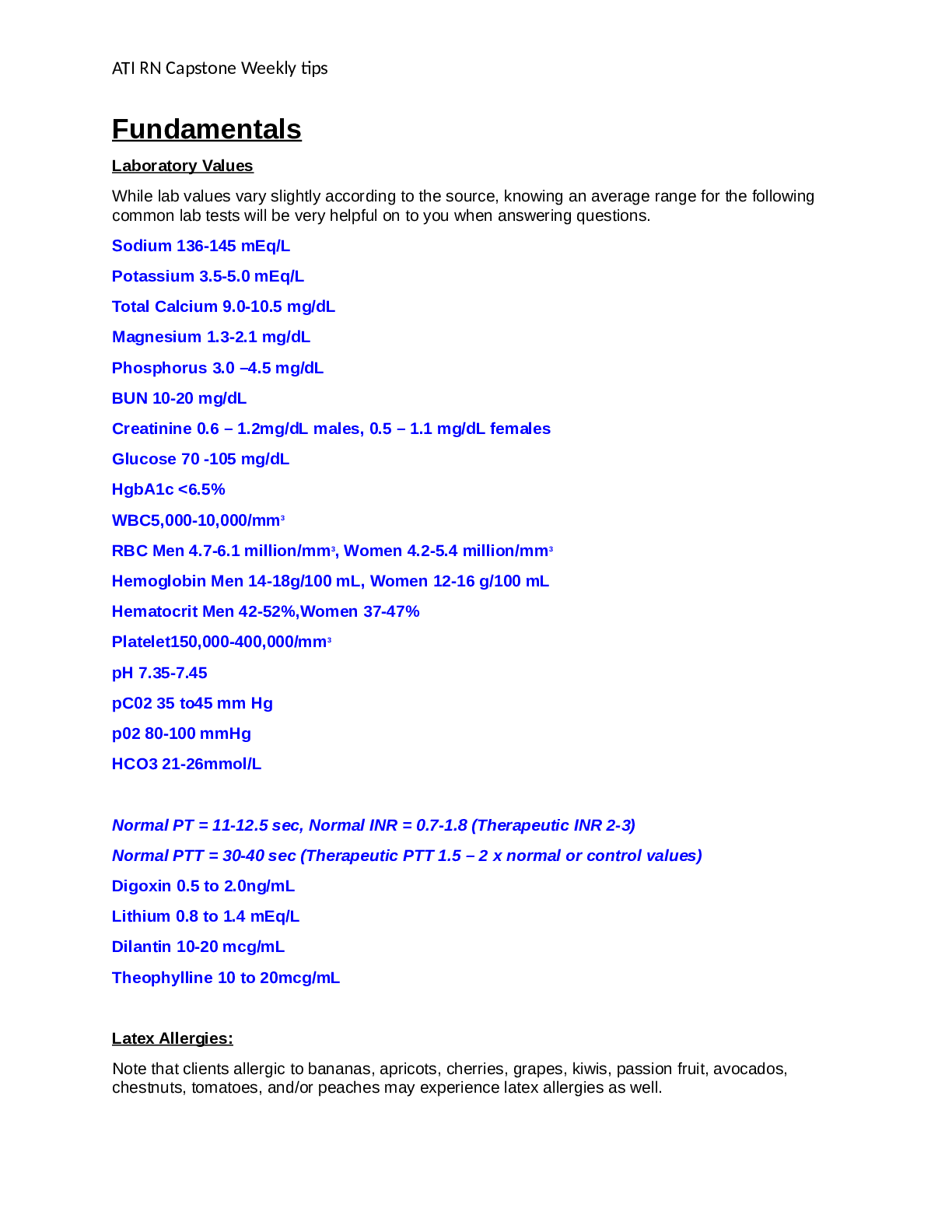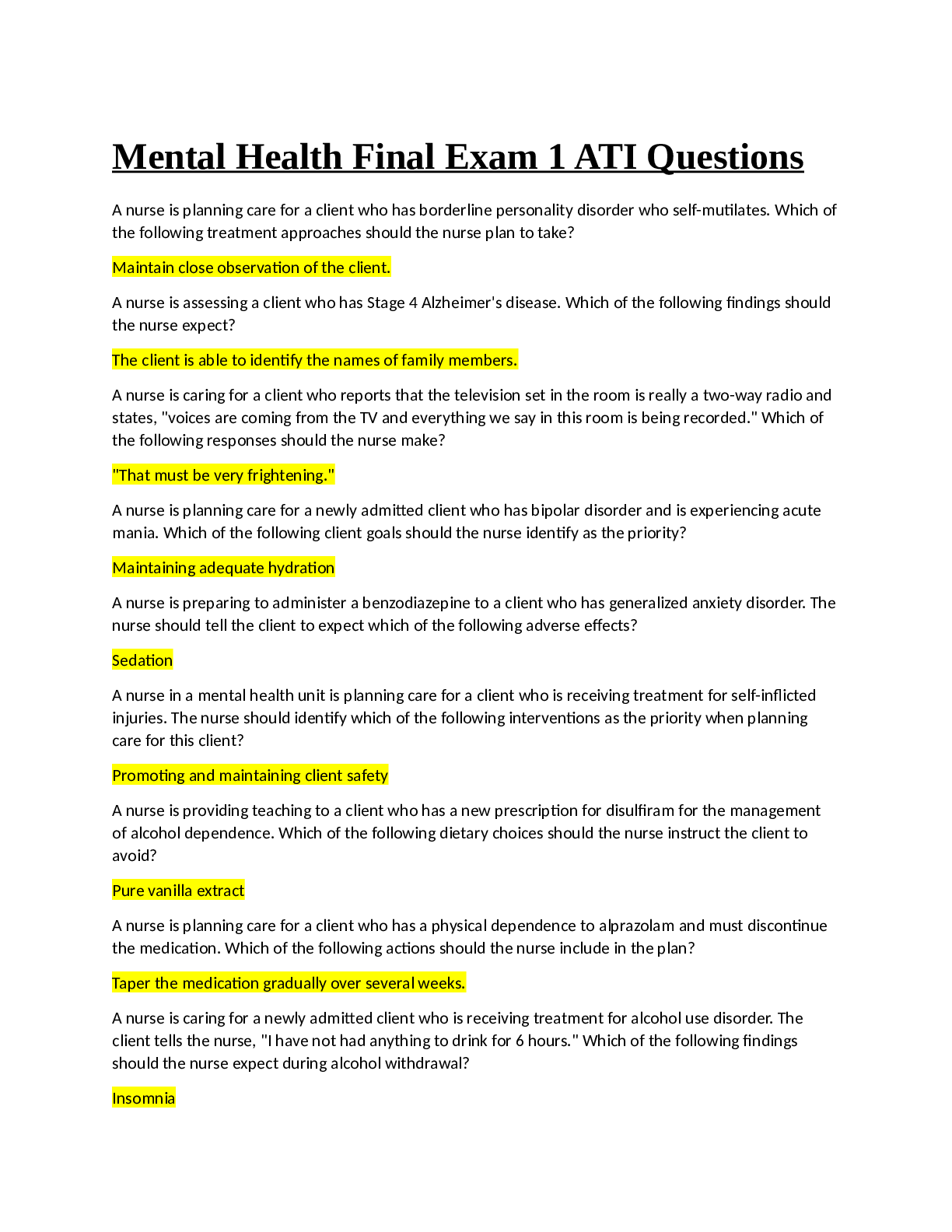*NURSING > QUESTIONS and ANSWERS > ATI Pharmacology 2019 B/ATI Pharmacology 2019 B (All)
ATI Pharmacology 2019 B/ATI Pharmacology 2019 B
Document Content and Description Below
1) A nurse is caring for a pt who is receiving Haloperidol. The nurse should identify which of the following findings as an adverse effect of the med? -Akathisia = CORRECT ANSWER An adverse effect... associated with haloperidol is the development of extrapyramidal manifestations such as dystonia, pseudoparkinsonism, and akathisia. -Paresthesia Haloperidol, an antipsychotic neuroleptic medication, can cause CNS adverse effects such as seizures, confusion, and neuroleptic syndrome. However, paresthesia is not an adverse effect of haloperidol. -Excess tear production Haloperidol has anticholinergic properties that can cause sensory adverse effects such as increased intraocular pressure, blurred vision, and dry eyes. -Anxiety Haloperidol can be prescribed to treat severe agitation as well as psychotic manifestations. 2) A nurse is providing teaching to a pt who is to start taking Sumatriptan. Which of the following adverse effects should the nurse instruct the pt to monitor for and report to the provider? -Chest pressure= CORRECT ANSWER Sumatriptan is an antimigraine agent which can cause coronary vasospasms, resulting in angina. The client should report chest pressure or heavy arms to the provider. -White patches on the tongue White patches on the tongue can indicate a fungal infection, which is not an adverse effect of sumatriptan. -Bruising Ecchymosis can indicate thrombocytopenia, which is not an adverse effect of sumatriptan. -Insomnia Sumatriptan can cause drowsiness and sedation as an adverse effect of the medication. 3) A nurse is teaching a pt who is starting to take Amitriptyline. Which of the following findings should the nurse include in the teaching as an adverse effect of the med? -Diarrhea Constipation is an adverse effect of amitriptyline. -Cough Developing a cough is not an adverse effect of amitriptyline. -Urinary retention = CORRECT ANSWER The nurse should instruct the client that amitriptyline causes the anticholinergic effect of urinary retention. -Increased libido A decrease in libido is an adverse effect of amitriptyline. 4) A nurse is assessing a pt who is taking Tamoxifen to treat breast cancer. Which of the following findings is the priority for the nurse to report to the provider? -Hot flashes The client is at risk for hot flashes as an adverse effect of tamoxifen; however, another finding is the priority to report to the provider. The nurse should encourage the client to avoid caffeine and spicy foods to prevent hot flashes. -Gastrointestinal irritation The client is at risk for gastrointestinal irritation (GI) as an adverse effect of tamoxifen; however, another finding is the priority to report to the provider. The nurse should administer the medication with food or fluids to reduce GI irritation. -Vaginal dryness The client is at risk for vaginal dryness as an adverse effect of tamoxifen; however, another finding is the priority to report to the provider. The nurse should encourage the client to use vaginal moisturizers if dryness occurs. -Leg tenderness = CORRECT ANSWER The greatest risk to this client is the development of a thromboembolism, which is an adverse effect of tamoxifen. The nurse should also monitor the client for other manifestations of a thromboembolism, including leg tenderness, redness, swelling, and shortness of breath. 5) A nurse is teaching a pt who is taking Allopurinol for the treatment of gout. Which of the following info should the nurse include in the teaching? -Plan to increase the dosage each week by 200 mg increments. The nurse should instruct the client to increase the dosage each week by 50 to 100 mg until they experience relief or reach a maximum of 800 mg daily. -Prolonged use of the medication can cause glaucoma. The nurse should instruct the client that the prolonged use of allopurinol can cause cataracts; therefore, the client should have periodic ophthalmic checkups. -Drink 2 L of water daily. = CORRECT ANSWER The nurse should instruct the client to drink at least 2 L of water each day to prevent renal stone formation and kidney injury, because allopurinol is eliminated through the kidneys. -A fine red rash is transient and can be treated with antihistamines. The nurse should instruct the client to report a rash to the provider immediately as this can be an indication of hypersensitivity syndrome, a life-threatening toxicity. Treatment for allopurinol toxicity can require hemodialysis or the administration of glucocorticoid medications 6) A nurse is caring for a pt who has diabetes mellitus and is taking Glyburide. The pt reports feeling confused and anxious. Which of the following actions should the nurse take first? -Perform a capillary blood glucose test. = CORRECT ANSWER The greatest risk to this client is injury from hypoglycemia. Therefore, the nurse should perform a capillary blood glucose test to determine the client's blood glucose status. Manifestations of hypoglycemia include weakness, anxiety, confusion, sweating, and seizures. -Provide the client with a protein-rich snack. The nurse should provide the client with a protein-rich snack after determining the client's blood glucose value and providing a carbohydrate first. However, there is another action that the nurse should take first. -Give the client 120 mL (4 oz) of orange juice. The nurse should give the client 10 to 15 g of carbohydrates, such as 4 oz of orange juice, to treat hypoglycemia. However, there is another action that the nurse should take first. -Schedule an early meal tray. The nurse should schedule an early meal tray to maintain the client's blood glucose level following the initial interventions for hypoglycemia. However, there is another action the nurse should take first. 7) A nurse is administering Cefotetan via intermittent IV bolus to a pt who suddenly develops dyspnea and widespread hives. Which of the following actions should the nurse take first? -Administer epinephrine 0.5 mL via IV bolus. The nurse should administer epinephrine, which is a beta-adrenergic agonist that can stimulate the heart, cause vasoconstriction of blood vessels in the skin and mucous membranes, and cause bronchodilation in the lungs. However, there is another action the nurse should take first. -Discontinue the medication IV infusion. = CORRECT ANSWER The greatest risk to the client is respiratory arrest from anaphylaxis. Therefore, the first action the nurse should tak [Show More]
Last updated: 2 years ago
Preview 1 out of 25 pages

Buy this document to get the full access instantly
Instant Download Access after purchase
Buy NowInstant download
We Accept:

Reviews( 0 )
$15.50
Can't find what you want? Try our AI powered Search
Document information
Connected school, study & course
About the document
Uploaded On
Mar 10, 2021
Number of pages
25
Written in
Additional information
This document has been written for:
Uploaded
Mar 10, 2021
Downloads
0
Views
82














